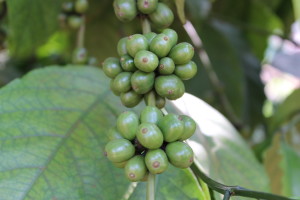Rural Development
Slash and burn agriculture has been identified as one of the main drivers of deforestation in the DRC. Most forest communities in Équateur province are extremely poor, which makes them highly dependent of forest resources to sustain their livelihoods. Wide scale poverty, along with the lack of access to other energy sources, also means that fuelwood for household use is high, which also contributes to deforestation. Projet Équateur, through action-research methods, is testing different activities to find the most efficient ways to reduce deforestation and help improve the lives of these communities. WHRC works with a local non-governmental organization, the Support Team for Endogenous Development (EADE), to implement and test different approaches from community level interventions to household level activities.
Current activities:
Agroforestry Plots & Farmer Field Schools: To encourage more sustainable agricultural practices, WHRC, EADE and the Botanical Garden of Eala have set up agroforestry plots to demonstrate how the cultivation of fruit trees can be a additional source of food and income. Projet Équateur has also proposed trainings to help improving the productivity and sustainability of staple crops such as cassava and corn through a farmer field school approach.
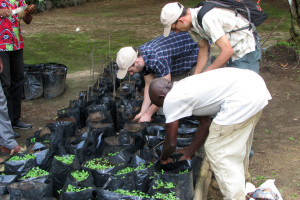
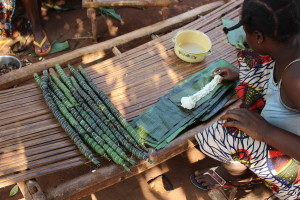 Project Manager Melaine Kermarc and agronomist Robin Brunet inspect seedlings in Buya 1
The DRC is the number one consumer of cassava in the world. Here, a dish called chikwangue is prepared from fermented cassava paste wrapped in banana leaves. This will ensure it is preserved, even in the hot, humid climate.
Project Manager Melaine Kermarc and agronomist Robin Brunet inspect seedlings in Buya 1
The DRC is the number one consumer of cassava in the world. Here, a dish called chikwangue is prepared from fermented cassava paste wrapped in banana leaves. This will ensure it is preserved, even in the hot, humid climate.


Social Infrastructures: While not being direct driver of deforestation, health issues and lack of access to education play an important role in the medium and longer term development of the province. WHRC is attempting to address those indirect drivers by providing social infrastructures, such as schools and water points. The use of local materials is paramount in these actives in order to avoid displacing emissions. The hiring of a local labor force also enabling the project to invest in local economy as well as offer new skills and alternative economic activities to the local communities. Other household level interventions, such as improved stoves and our cassava dryer attempt to address the high demand for fuel wood and ease the burden and emissions of transforming agricultural products.
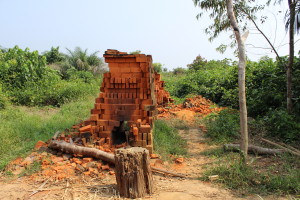
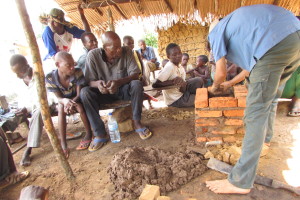
These bricks have been made from nearby mud, making them both cheaper and more environmentally friendly than importing cement. They are also extremely durable, and can be used in the construction of schools, improved cookstoves, and much more.
Improved cookstoves can reduce fuelwood consumption by up to 70%. This also means that that women, who are primarily responsible for collecting this wood, can reallocate this time lost to other economic activities or education.
System of Rice Intensification: Équateur province has a market for locally grown rice, but the yields in the province are generally low. Wetland rice production has the advantage of being a high yielding and sedentary agricultural practice, given the intensive work it takes to establish a paddy. WHRC is currently testing the System of Rice Intensification (SRI) method which improves productivity with less water and without chemical inputs. The early results have been encouraging, with a threefold increase in yield compare with traditional local practices.
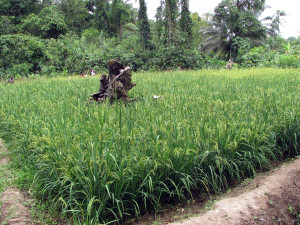
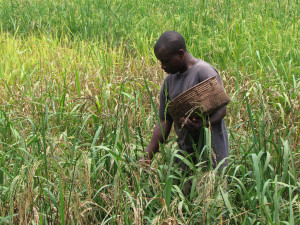
Stump removal is laborious and time consuming, and often times farmers are forced to work around them.
A man from Buya 1 begins the harvest of the SRI test plots.
Rehabilitation of degraded land: Traditionally, local communities would leave fields for a fallow period of 25 years or more to ensure the restored fertility of their soil. With a growing population and an increasing demand for land, fallow periods have been shortening drastically and deforestation is increasing. Additionally, the carbonization of those plots helps reduce the labor needed to prepare the plots, as well as fertilizes the soil with the ashes. Using a leguminous vine called mucuna (mucuna bracteate and mucuna pruriens), WHRC and EADE are attempting to rehabilitate degraded fallow land and improve the fertility of soils to encourage a more sedentary and rotational style of farming. The planting of mucuna not only reduces the fallow period drastically and improves soil fertility, but also reduces the need for weeding and uprooting stumps from deforested plots, which requires intensive labor.
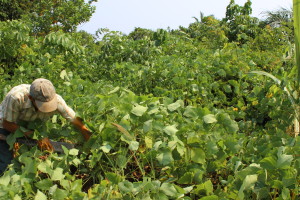
According to national statistics, there are over 44,000 hectares of abandoned cocoa, oil palm, rubber and coffee plantations in Équateur province alone.
Mucuna is highly effective in restoring soil fertility, reducing weeding, and helping sedentarize agriculture.
Gender and Vulnerable Individuals: Gender, class, race and landholding status can limit the capacity of an individual to take part in or benefit from certain activities. For this reason, the Projet Equateur team tries to mainstream the involvement of vulnerable groups at all stages of planning, implementation and monitoring of activities. By critically assessing our work, we attempt to emphasize the importance of equity and find innovative ways to engage with vulnerable groups. An independent study on gender participation into the consultation process (FPIC) for the development of the project helped WHRC understand some of the shortcomings and way to improve the participation of women in meeting and activities.* In a similar way, we were also able to identified internal migrants as an often overlook vulnerable group in our target communities, alongside women, pygmies and youth.
*A link to this paper is provided here.

